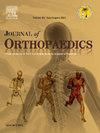桡骨远端骨折切开复位内固定术后手术年龄对短期疗效和再住院率的影响
IF 1.5
Q3 ORTHOPEDICS
引用次数: 0
摘要
手术时患者年龄的增加与手部手术后的不良后果有关。然而,手术与非手术治疗老年人桡骨远端骨折(DRFs)的数据存在差异。因此,有必要确定患者年龄对DRFs切开复位内固定(ORIF)后短期预后的影响。方法使用国家再入院数据库确定接受ORIF治疗DRFs的患者。患者根据手术年龄分层,包括:18-49岁、50-59岁、60-69岁、70-79岁和80+岁;对65岁及≥65岁患者进行进一步亚分析。比较人口学、并发症、再入院、总费用和住院时间(LOS)信息。结果18-49岁、50-59岁、60-69岁、70-79岁和80+岁年龄组分别有12,766例、5,113例、5,639例、4,901例和4260例患者;65岁患者20,674例,≥65岁患者12,005例。年龄较大的患者30天内的两种并发症发生率均较高(OR: 1.19, p <;0.01)和90天再入院(OR: 1.31;p & lt;0.01)。比较65岁和≥65岁,30天和90天再入院率分别为5.2%、7.0%、8.6%和13.3%。年龄较小是感染并发症的独立预测因子(OR: 0.55;p = 0.029)和正中神经损伤(OR: 0.77;p & lt;0.01),以≥65岁为自变量。随着年龄的增加,总成本逐步下降(p <;年龄大于65岁的患者住院天数比年龄较小的患者平均短2.0天(p <;0.01)。结论年龄的增加与再入院率的增加有关,但与ORIF治疗DRF后感染、神经损伤、LOS和相关总费用的减少有关。本研究应与临床结果文献结合使用,以适当地向患者提供有关DRFs固定的并发症和预期结果的建议。本文章由计算机程序翻译,如有差异,请以英文原文为准。
The impact of age at surgery on short-term outcomes and readmissions following open reduction internal fixation for distal radius fractures
Background
Increasing patient age at the time of surgery has been associated with adverse outcomes following hand surgeries. However, heterogeneous management data exists for operative versus nonoperative management of distal radius fractures (DRFs) in the elderly. Thus, it is imperative to characterize the impact patient age has on short-term outcomes following open reduction and internal fixation (ORIF) for DRFs.
Methods
Patients who underwent ORIF for DRFs were identified using the National Readmissions Database. Patients were stratified into cohorts based on age at surgery, including: 18–49, 50–59, 60–69, 70–79, and 80+ years old; further sub-analysis of patients <65 and ≥ 65 years old was also conducted. Demographic, complication, readmission, total cost, and length of stay (LOS) information was compared.
Results
12,766, 5,113, 5,639, 4,901, and 4260 patients were identified in the 18–49, 50–59, 60–69, 70–79, and 80+ years old cohorts, respectively; 20,674 patients were <65 years old and 12,005 were ≥65 years old were. Older patients had higher rates of both 30-day (OR: 1.19, p < 0.01) and 90-day readmissions (OR: 1.31; p < 0.01). Comparing age <65 vs. ≥65 years, the 30- and 90-day readmissions were 5.2 % vs. 7.0 % and 8.6 % and 13.3 %, respectively. Younger age was an independent predictor of infection complications (OR: 0.55; p = 0.029) and median nerve injury (OR: 0.77; p < 0.01) after ORIF, with ≥65 years of age as the independent variable. There was a stepwise decrease in overall costs with increasing age (p < 0.01) and those older than 65 years stayed in the hospital on average 2.0 days shorter than their younger counterparts (p < 0.01).
Conclusion
Increasing age was associated with increased readmission, but decreased infections, nerve injury, LOS, and related total charges after ORIF for DRF. This study should be utilized in conjunction with clinical outcomes literature to appropriately counsel patients as to the complications and expected outcomes related to fixation of DRFs.
求助全文
通过发布文献求助,成功后即可免费获取论文全文。
去求助
来源期刊

Journal of orthopaedics
ORTHOPEDICS-
CiteScore
3.50
自引率
6.70%
发文量
202
审稿时长
56 days
期刊介绍:
Journal of Orthopaedics aims to be a leading journal in orthopaedics and contribute towards the improvement of quality of orthopedic health care. The journal publishes original research work and review articles related to different aspects of orthopaedics including Arthroplasty, Arthroscopy, Sports Medicine, Trauma, Spine and Spinal deformities, Pediatric orthopaedics, limb reconstruction procedures, hand surgery, and orthopaedic oncology. It also publishes articles on continuing education, health-related information, case reports and letters to the editor. It is requested to note that the journal has an international readership and all submissions should be aimed at specifying something about the setting in which the work was conducted. Authors must also provide any specific reasons for the research and also provide an elaborate description of the results.
 求助内容:
求助内容: 应助结果提醒方式:
应助结果提醒方式:


